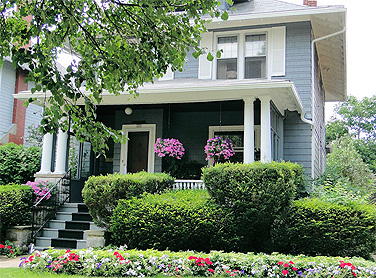News
University Park on National Register
a boon for property owners

Homes in the University Park Historic District are now eligible for state and federal tax credits.
The University Park Historic District adjacent to the UB South Campus has been added to the National Register of Historic Places, thanks to a collaborative effort by UB, the New York State Historic Preservation Office (NYSHPO) and the city of Buffalo.
The University Park district was listed on the New York State Register of Historic Places in December, which will bring certain state and federal tax benefits to property owners in the University Park District for the 2010 tax year.
Architect and architectural historian Kerry Traynor, UB clinical associate professor of architecture and urban and regional planning, and president of the historic preservation consulting firm kta preservation specialists, was instrumental in helping to initiate the collaboration.
Traynor explains there are two types of historic preservation incentive tax credits that University Park District property owners my look for: federal and state.
“The Federal Historic Rehabilitation Tax Credit,” she says, “is available only for the rehabilitation of income-producing properties listed on the National Register of Historic Places or for the rehabilitation of income-producing buildings that contribute to the inclusion of a district listed on the National Register.
“The fantastic thing,” she says, “is that, thanks to a new state law, home owners in the University Park District are eligible for tax credits under the New York State Homeowners Rehabilitation Tax Credit Program.
“The program, now in its first year, falls under the umbrella of the Office of Parks Recreation and Historic Preservation,” Traynor says, “and is administered by the State Historic Preservation Office.”
The bill, signed into law in 2009 by Gov. David Paterson, was sponsored by Assemblyman Sam Hoyt and Sen. David Valesky. The tax-credit program for residential properties will sunset in 2014.
Traynor says state law has long permitted houses defined as “certified historic buildings” by New York state and the National Park Service to qualify for state tax credits. Local districts that have been certified for the purposes of tax credits also qualify. They include the Allentown District, the Linwood District and the Joseph Ellicott District.
The new law passed by New York state offers a 20-percent tax incentive for the rehabilitation of historic residential properties located in qualified census tracts, including the one that encompasses the University Park District.
The new state tax incentive, Traynor says, may be applied to much of the work performed on such properties, but does not include landscaping or site work, like driveway improvements.
“Credit is given, for instance, for the costs incurred in the upkeep and rehabilitation of a historic home, such as painting, floors and roofs,” she says.
“It also covers improvements to such infrastructure as heating, plumbing and electrical systems—improvements quite apart from ‘restoration’ of the property to its original condition.”
Traynor says the eligibility of such improvements for the purpose of tax credit is determined through a NYSHPO review process. The review process may help to clarify and prioritize tasks needing to be done, and the SHPO staff is willing to provide technical assistance should a property owner request it.
She also says that property owners should know that if changes already have been made to the property, the property does not have to be returned to its original historical condition to make it eligible for tax credits.
“Again, the program is for rehabilitation, not restoration,” she says.
“For example, if a property’s original historic windows were replaced sometime in the past, the owner is not required to replace the existing windows with historical facsimiles to get a credit,” Traynor says.
But she points out that if the original windows are intact, the owner may not collect a tax credit for replacing existing historical units with non-historical units.
“SHPO staff provides numerous resources for the weatherization of historic windows,” she says, “and the cost and labor of their restoration can be included in the tax credit.
“As long as property owners are not applying for a tax credit, however, there are no restrictions as to what they can do to their properties,” she says, “although we do urge property owners in the new historic district to honor the history of their homes.”
University Park is one of the areas included in UB’s Home Loan Guaranty Program, a program administered by the Office of Community Relations to encourage UB employees to buy homes to help revitalize the neighborhood around the South Campus.

Reader Comments